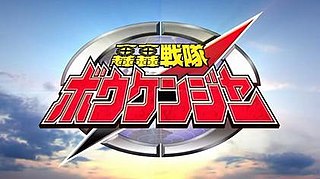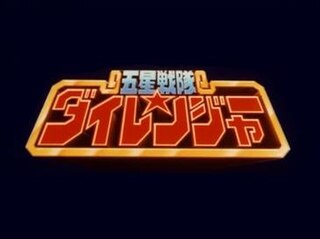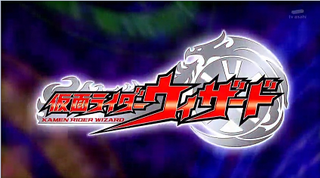 W
WBakuryū Sentai Abaranger is Toei's twenty-seventh production of the Super Sentai metaseries, and the first series to use TV Asahi's current logo. It aired as a part of TV Asahi's 2003 Super Hero Time block with Kamen Rider 555. The series is based on dinosaurs and explosions. Its action footage was used in Power Rangers Dino Thunder. In addition, episode 10 in nearly its entirety was used for episode 19 of Power Rangers Dino Thunder as an English-dubbed show that the Dino Thunder Power Rangers discover on television.
 W
WChōjin Sentai Jetman is a Japanese tokusatsu television series produced by Toei Company and Bandai. It is the fifteenth entry of the Super Sentai metaseries, following the previous series Chikyu Sentai Fiveman. The series aired on TV Asahi on February 15, 1991, to February 14, 1992, with a total of 51 episodes. It is the last Sentai series until Ressha Sentai ToQger to not get adapted into a Power Rangers series. It was also the first series to have a third robot, Tetra Boy.
 W
WChouriki Sentai Ohranger is a Japanese tokusatsu television series and the 19th installment in the long-running Super Sentai metaseries of superhero programs. It is the second ancient civilization-themed Super Sentai, preceded by Dai Sentai Goggle-V. Its footage was used in the American series, Power Rangers Zeo.
 W
WDenji Sentai Megaranger is Toei's twenty-first production of the Super Sentai metaseries, and the Second Sentai where all heroes are high school students. The footage was also used in the American series, Power Rangers in Space. Megaranger premiered on February 14, 1997, and concluded on February 15, 1998.
 W
WFushigi no Kuni no Alice is an anime adaptation of the 1865 novel Alice's Adventures in Wonderland which ran on the TV Tokyo network and other local stations across Japan from October 10, 1983 to March 26, 1984. The series was a Japanese-German co-production between Nippon Animation, TV Tokyo affiliate station TV Osaka, and Apollo Films. The series consists of 52 episodes, however, only 26 made it to the US.
 W
WGekisou Sentai Carranger is a Japanese tokusatsu television show. It was Toei's twentieth production of the Super Sentai metaseries. It is the second vehicle-themed Super Sentai, preceded by Kousoku Sentai Turboranger. The show was written as a parody of its own franchise. Its action footage was used in Power Rangers Turbo.
 W
WGoGo Sentai Boukenger is the 30th series in Toei's Super Sentai series, a metaseries of Japanese tokusatsu programming. It is the first installment to be broadcast in 16:9 aspect ratio. It premiered on February 19, 2006 at 7:30 JST on TV Asahi's 2006 Super Hero Time programming block with Kamen Rider Kabuto. Its footage was used in the American series, Power Rangers Operation Overdrive in SD, while the original footage was dubbed into Korean for the South Korean series, Power Rangers Treasure Force.
 W
WGosei Sentai Dairanger is a Japanese tokusatsu television series. It was the seventeenth production in the long-running Super Sentai metaseries of television tokusatsu dramas produced by Toei Company, following Kyōryū Sentai Zyuranger. It was originally broadcast from February 19, 1993, to February 11, 1994. Toei gave this series the name Star Rangers for international distribution.
 W
WDenkou Choujin Gridman , known as Gridman the Hyper Agent in some English-speaking territories, is a 1993–1994 Japanese tokusatsu "Giant Hero" series created by Tsuburaya Productions and would be Tsuburaya's last non-Ultra superhero production before Bio Planet WoO. It was the inspiration and source material for DiC Entertainment's Superhuman Samurai Syber-Squad.
 W
WHyakujuu Sentai Gaoranger is Toei's twenty-fifth production of the Super Sentai metaseries airing in 2001 and celebrated the franchise's 25th anniversary. Footage from this show was used in the 2002 American series Power Rangers Wild Force and was later dubbed in 2010 as the retitled Power Rangers: Jungle Force for South Korean television in place of Samurai Sentai Shinkenger. Gaoranger aired alongside Kamen Rider Agito.
 W
WJuken Sentai Gekiranger is Toei Company's thirty-first entry in the Super Sentai metaseries. Production began on September 29, 2006 with principal photography beginning on October 6, 2006. It premiered on February 18, 2007 on TV Asahi's 2007 Super Hero Time programming block with Kamen Rider Den-O, and concluded its airing on February 10, 2008.
 W
WKamen Rider Black Sun is a tokusatsu superhero-drama series and a reboot of the 1987 series Kamen Rider Black. A co-production between Ishimori Productions and Toei, the series is directed by Kazuya Shiraishi and scheduled for release in Spring 2022 in Japan as part of the celebrations of the 50th anniversary of the Kamen Rider Series.
 W
WKamen Rider Gaim is a Japanese television series, a tokusatsu drama that is in the Kamen Rider Series; it is the 15th series during its Heisei run and 24th overall. The series, written by Gen Urobuchi, directed by Ryuta Tasaki and produced by Naomi Takebe, began airing on TV Asahi from October 6, 2013, replacing Kamen Rider Wizard in its initial timeslot and joining Zyuden Sentai Kyoryuger then Ressha Sentai ToQger in the Super Hero Time programming block, until Gaim concluded on September 28, 2014.
 W
WKamen Rider Ryuki is a Japanese tokusatsu television series. The twelfth installment in the Kamen Rider Series of tokusatsu shows, it was a joint collaboration between Ishimori Productions and Toei, and it was shown on TV Asahi from February 3, 2002 to January 19, 2003. The series marked the franchise's switch from Columbia Music Entertainment to Avex Group, which continues to produce music for the Kamen Rider Series today. The series aired along with Ninpuu Sentai Hurricaneger.
 W
WKamen Rider Saber is a Japanese tokusatsu drama, the 31st entry of Toei Company's Kamen Rider franchise, and the second series to debut during the Reiwa period. The series premiered on September 6, 2020, joining Mashin Sentai Kiramager, and later, Kikai Sentai Zenkaiger in the Super Hero Time line-up after the finale of Kamen Rider Zero-One before being succeeded by Kamen Rider Revice on September 5, 2021. The series is notable for its use of a fantasy setting, along with its storybook theming.
 W
WKamen Rider Wizard is a Japanese tokusatsu drama in Toei Company's Kamen Rider franchise, being the fourteenth series in the Heisei period run and the twenty-third overall. It began airing on TV Asahi on September 2, 2012, joining Tokumei Sentai Go-Busters and then Zyuden Sentai Kyoryuger in the Super Hero Time lineup. Tsuyoshi Kida is the series' main screenwriter.
 W
WKousoku Sentai Turboranger is both the thirteenth entry of Toei Company's Super Sentai metaseries and the first title of the Heisei period. it was aired on TV Asahi on February 25, 1989 to February 23, 1990 with a total of 51 episodes. Its international title in English was listed by Toei is Turbo Rangers. Turboranger was also the first Super Sentai series to air on Friday instead of Saturday.
 W
WKyōryū Sentai Zyuranger is a Japanese tokusatsu television series and the sixteenth installment in the long-running Super Sentai metaseries of superhero programs. Produced by Toei and Bandai, it aired on TV Asahi from February 21, 1992 to February 12, 1993, with a total of 50 episodes. It was the first Sentai series to have a regular Sixth Ranger, and the first to introduce the concept of sentient, living mecha—a theme that has been used frequently in the franchise ever since. It was also the first Sentai series to be adapted into an installment of the American Power Rangers series. Footage from all 50 episodes was extensively used for the first season of Mighty Morphin Power Rangers. The core Zyuranger costumes were used in all three seasons of Mighty Morphin Power Rangers and were used as the original Power Rangers costumes while the Dragon Ranger costume was adapted into the Green Ranger's costume and was used throughout Season 1 and in early Season 2. The title Toei gives this series for international distribution is Galaxy Rangers.
 W
WKyuukyuu Sentai GoGoFive is the twenty-third entry of the long-running Japanese Super Sentai metaseries. Its footage was used in the American television series, Power Rangers Lightspeed Rescue.
 W
WMahō Sentai Magiranger is Toei Company's twenty-ninth production of the Super Sentai metaseries. The action footage was used in Power Rangers Mystic Force and both shows had scenes simultaneously shot in New Zealand. The main themes of this series are courage and love of family. This series was dubbed into Korean under the title Power Rangers Magic Force.
 W
WMirai Sentai Timeranger is a Japanese Tokusatsu television series and the 24th series in Toei's Super Sentai metaseries. Footage from this series was used in the American production Power Rangers Time Force. The opening narration of the series announces, "People from the future in the year 3000 AD and one man have met by chance, for the sake of marking a new passage of time…!" . Timeranger was released on DVD by Shout! Factory in North America on July 31, 2018. This is the 9th Super Sentai Series to be released on Region 1 DVD in North America. The series debuted on February 13, 2000, when it replaced Kyuukyuu Sentai GoGoFive in TV Asahi's 7:30 JST time-slot, joining the recently-debuted Kamen Rider Kuuga in what would 3 years later become the Super Hero Time programming block.
 W
WSaiyūki , also known by its English title Monkey, is a Japanese television drama based on the 16th-century Chinese novel Journey to the West by Wu Cheng'en. Filmed in Northwest China and Inner Mongolia, the show was produced by Nippon TV and International Television Films and broadcast from 1978 to 1980 on Nippon TV.
 W
WNinja Sentai Kakuranger is a Japanese tokusatsu television series. It was Toei Company Limited's eighteenth production of the Super Sentai metaseries. The name given to this series by Toei for international distribution is Ninja Rangers.
 W
WNinpuu Sentai Hurricaneger is Toei's twenty-sixth production of the Super Sentai metaseries. The catchphrase for the series is "Unknown even to others, unknown even to the world, we become shadows to defeat evil!" . Its footage was used in the American series, Power Rangers Ninja Storm. On April 1, 2013, Shun Shioya, Nao Nagasawa, Kohei Yamamoto, Yujiro Shirakawa, and Nobuo Kyo, who played Hurricane Red, Hurricane Blue, Hurricane Yellow, Kabuto Raijer, and Kuwaga Raijer, respectively, announced that a 10th-anniversary V-Cinema release called Ninpuu Sentai Hurricaneger: 10 Years After would be produced. This is the first time a movie has been made commemorating the anniversary of a single Sentai series. The movie is a direct to DVD and Blu-ray release. Shout! Factory released Ninpuu Sentai Hurricaneger: The Complete Series in North America on March 26, 2019. This is the twelfth Super Sentai series to be released in North America. It joined Kamen Rider Ryuki.
 W
WPretty Guardian Sailor Moon is a Japanese tokusatsu television series based on the Sailor Moon manga created by Naoko Takeuchi. It was produced by Toei Company.
 W
WSeijuu Sentai Gingaman is a Japanese tokusatsu television series. It is Toei's 22nd entry of the Super Sentai metaseries. The series aired from February 22, 1998, to February 14, 1999. Its footage was used in Power Rangers Lost Galaxy. The lead screenwriter for the series is Yasuko Kobayashi.
 W
WSignal , also known as Signal: Long-Term Unsolved Case Investigation Team , is a Japanese police procedural television series starring Kentaro Sakaguchi, Michiko Kichise and Kazuki Kitamura. It is a remake of the South Korean drama of the same name written by Kim Eun-hee, and aired every Tuesday at 21:00 JST from April 10 to June 12, 2018 on Fuji TV.
 W
WTaiyo Sentai Sun Vulcan is the fifth series in Toei Company's Super Sentai tokusatsu metaseries. It was broadcast from February 7, 1981, to January 30, 1982, and is the first Super Sentai series to serve as a direct sequel to its previous series. It is also the first and only series in the franchise to have an all-male Super Sentai team and the first to have fewer than five members in the core team. Its international English title as listed by Toei Company is Sunvulcan.
 W
WTensou Sentai Goseiger is the title of Toei Company's 34th entry in its long-running Super Sentai franchise. It follows an angelic motif as well as a trading card theme. It joined Kamen Rider W, and later Kamen Rider OOO, as a program featured in TV Asahi's Super Hero Time programming block. The series ties in with the arcade game Super Sentai Battle: Dice-O, with the characters using cards resembling Carddass cards used in the game to transform and access various weapons, similar to the concept of Kamen Rider Decade and its link to Kamen Rider Battle: Ganbaride. Goseiger's footage was later used for the 2013 Power Rangers series Power Rangers Megaforce and 1 episode of the 2014 Power Rangers series Power Rangers Super Megaforce.
 W
WTokusou Sentai Dekaranger is the title given to the promotional material for the twenty-eighth production of the Super Sentai metaseries produced by Toei. It aired as a part of TV Asahi's 2004 Super Hero Time block with Kamen Rider Blade. The action footage from the show was used for the American series, Power Rangers S.P.D..
 W
WUltraman: Towards the Future, released in Japan as Ultraman Great , is a Japanese–Australian tokusatsu science fiction television series produced as a co-production between Tsuburaya Productions and the South Australian Film Corporation. It is the 10th installment in the Ultra Series, the first series to be produced during Japan's Heisei period and the third foreign production in the franchise after Ultraman: The Adventure Begins.